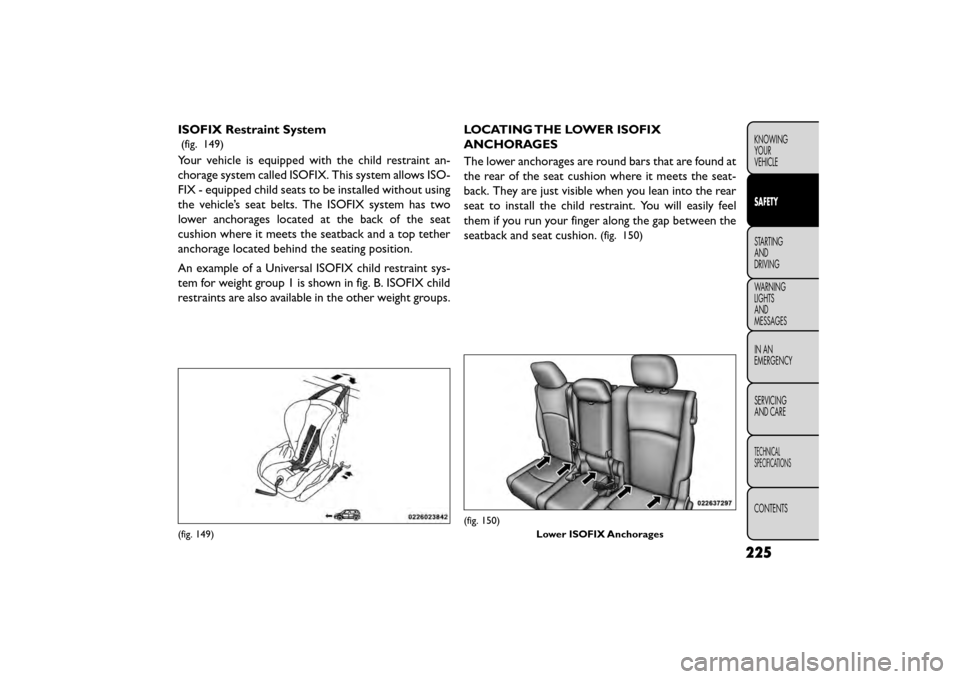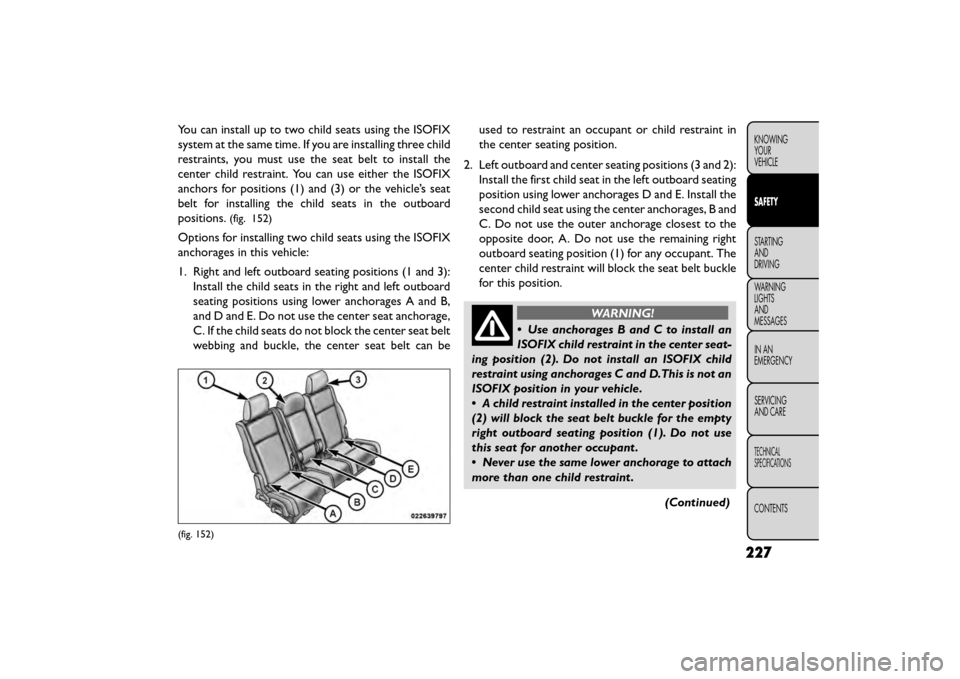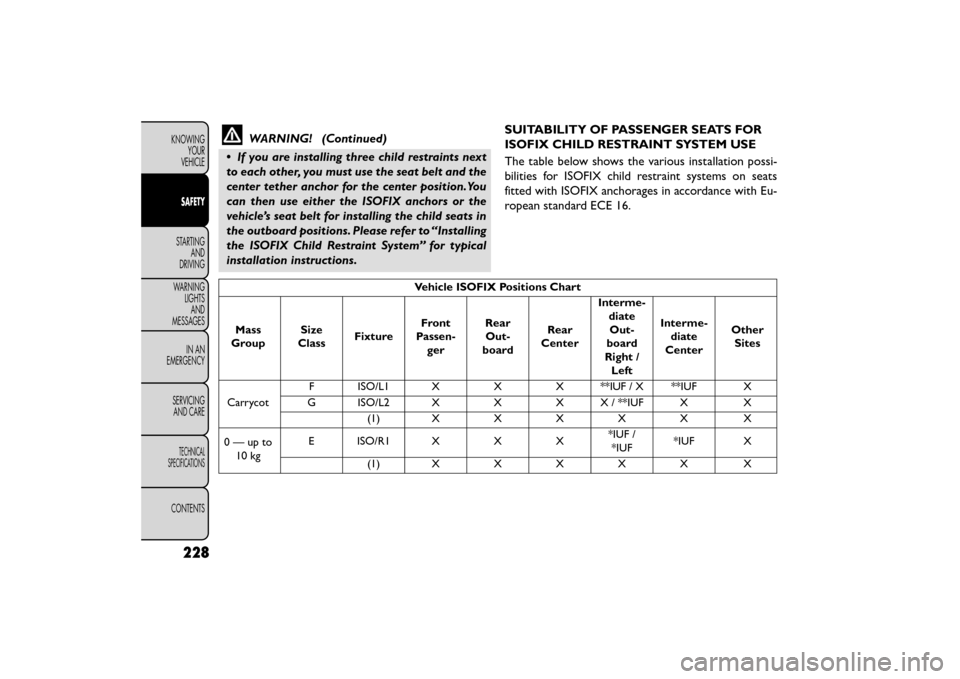2016 FIAT FREEMONT belt
[x] Cancel search: beltPage 227 of 412

INTEGRATED CHILD BOOSTER SEAT (for
versions/markets, where provided)
The Integrated Child Booster Seat is located in each
outboard second-row passenger seat. The Booster
Seat is designed for children weighing between 22 and
39 kg and between 119 cm and 145 cm tall.
To position a child into the Integrated Child Booster
Seat follow these steps:
1. Slide the second row seat to the full rear position touse the Integrated Child Booster Seat. NOTE: The
second row bench with Integrated Child Booster
Seat must remain in the full rear position during use.
2. Pull the release loop forward to release the latch and seat cushion. (fig. 146) 3. Lift the seat cushion up and push back to lock it in
the booster seat position. (fig. 147)
4. Place the child upright in the seat with their back firmly against the seatback.
5. Grasp the latch plate and pull out the seat belt.
6. Slide the latch plate up the webbing as far as neces- sary to allow the seat belt to go around the child’s
lap. NOTE: The lap portion of the seat belt should
be low on the hips and as snug as possible.
(fig. 146)
Release Loop(fig. 147) Booster Seat
221
KNOWING
YOUR
VEHICLE
SAFETY
STARTING
AND
DRIVING
WARNING
LIGHTS
AND
MESSAGES
IN
AN
EMERGENCY
SERVICING
AND CARE
TECHNICAL
SPECIFICATIONS
CONTENTS
Page 228 of 412

7. Once the seat belt is long enough to fit properly,insert the latch plate into the buckle until you hear
a “click.” (fig. 148)
8. To remove the slack from the lap belt, pull upward on the shoulder portion of the seat belt.
9. To release the seat belt, push the red button on the buckle.WARNING!
Securely lock the seat cushion into posi-
ti on
before using the seat . Otherwise,
the seat will not provide the proper stability for
child seats and/or passengers. An improperly
latched seat cushion could cause serious injury.
(fig. 148)
Proper Belt Use
222
KNOWINGYOUR
VEHICLE
SAFETY
STARTING AND
DRIVING
WARNING LIGHTSAND
MESSAGES
IN
AN
EMERGENCY
SERVICINGAND CARE
TECHNICAL
SPECIFICATIONS
CONTENTS
Page 230 of 412

Seat Belts For Older Children
Children over 1.50 m in height can wear seat belts
instead of using child restraints.
Use this simple 5-step test to decide whether the seat
belt properly fits the child or if they should still use a
Group 2 or Group 3 child restraint to improve the fit of
the seat belt:
1. Can the child sit all the way back against the back ofthe vehicle seat?
2. Do the child’s knees bend comfortably over the front of the vehicle seat – while they are still sitting
all the way back?
3. Does the shoulder belt cross the child’s shoulder between their neck and arm?
4. Is the lap part of the belt as low as possible, touching the child’s thighs and not their stomach?
5. Can the child stay seated like this for the whole trip? If the answer to any of these questions was “no,” then
the child still needs to use a Group 2 or 3 child restraint
in this vehicle. If the child is using the lap/shoulder belt,
check belt fit periodically and make sure the seat belt
buckle is latched. A child’s squirming or slouching can
move the belt out of position. If the shoulder belt
contacts the face or neck, move the child closer to the
center of the vehicle, or use a booster seat to position
the seat belt on the child correctly.
WARNING!
Never allow a child to put the shoulder
belt un
der an arm or behind their back.
In a crash, the shoulder belt will not protect a
child properly, which may result in serious injury
or death. A child must always wear both the lap
and shoulder portions of the seat belt correctly.
224
KNOWING YOUR
VEHICLE
SAFETY
STARTING AND
DRIVING
WARNING LIGHTSAND
MESSAGES
IN
AN
EMERGENCY
SERVICINGAND CARE
TECHNICAL
SPECIFICATIONS
CONTENTS
Page 231 of 412

ISOFIX Restraint System
(fig. 149)
Your vehicle is equipped with the child restraint an-
chorage system called ISOFIX. This system allows ISO-
FIX - equipped child seats to be installed without using
the vehicle’s seat belts. The ISOFIX system has two
lower anchorages located at the back of the seat
cushion where it meets the seatback and a top tether
anchorage located behind the seating position.
An example of a Universal ISOFIX child restraint sys-
tem for weight group 1 is shown in fig. B. ISOFIX child
restraints are also available in the other weight groups.LOCATING THE LOWER ISOFIX
ANCHORAGES
The lower anchorages are round bars that are found at
the rear of the seat cushion where it meets the seat-
back. They are just visible when you lean into the rear
seat to install the child restraint. You will easily feel
them if you run your finger along the gap between the
seatback and seat cushion.
(fig. 150)
(fig. 149)
(fig. 150)
Lower ISOFIX Anchorages
225
KNOWING
YOUR
VEHICLE
SAFETY
STARTING
AND
DRIVING
WARNING
LIGHTS
AND
MESSAGES
IN
AN
EMERGENCY
SERVICING
AND CARE
TECHNICAL
SPECIFICATIONS
CONTENTS
Page 233 of 412

You can install up to two child seats using the ISOFIX
system at the same time. If you are installing three child
restraints, you must use the seat belt to install the
center child restraint. You can use either the ISOFIX
anchors for positions (1) and (3) or the vehicle’s seat
belt for installing the child seats in the outboard
positions.
(fig. 152)
Options for installing two child seats using the ISOFIX
anchorages in this vehicle:
1. Right and left outboard seating positions (1 and 3):Install the child seats in the right and left outboard
seating positions using lower anchorages A and B,
and D and E. Do not use the center seat anchorage,
C. If the child seats do not block the center seat belt
webbing and buckle, the center seat belt can be used to restraint an occupant or child restraint in
the center seating position.
2. Left outboard and center seating positions (3 and 2): Install the first child seat in the left outboard seating
position using lower anchorages D and E. Install the
second child seat using the center anchorages, B and
C. Do not use the outer anchorage closest to the
opposite door, A. Do not use the remaining right
outboard seating position (1) for any occupant. The
center child restraint will block the seat belt buckle
for this position.
WARNING!
• Use anchorages B and C to install an
IS OFIX
child restraint in the center seat-
ing position (2). Do not install an ISOFIX child
restraint using anchorages C and D.This is not an
ISOFIX position in your vehicle.
• A child restraint installed in the center position
(2) will block the seat belt buckle for the empty
right outboard seating position (1). Do not use
this seat for another occupant .
• Never use the same lower anchorage to attach
more than one child restraint .
(Continued)
(fig. 152)
227
KNOWING
YOUR
VEHICLE
SAFETY
STARTING
AND
DRIVING
WARNING
LIGHTS
AND
MESSAGES
IN
AN
EMERGENCY
SERVICING
AND CARE
TECHNICAL
SPECIFICATIONS
CONTENTS
Page 234 of 412

WARNING! (Continued)
• If you are installing three child restraints next
to each other, you must use the seat belt and the
center tether anchor for the center position.You
can then use either the ISOFIX anchors or the
vehicle’s seat belt for installing the child seats in
the outboard positions. Please refer to “Installing
the ISOFIX Child Restraint System” for typical
installation instructions. SUITABILITY OF PASSENGER SEATS FOR
ISOFIX CHILD RESTRAINT SYSTEM USE
The table below shows the various installation possi-
bilities for ISOFIX child restraint systems on seats
fitted with ISOFIX anchorages in accordance with Eu-
ropean standard ECE 16.
Vehicle ISOFIX Positions Chart
Mass
Group Size
Class Fixture Front
Passen- ger Rear
Out-
board Rear
Center Interme-
diateOut-
board
Right / Left Interme-
diate
Center Other
Sites
Carrycot F ISO/L1 X X X **IUF / X **IUF X
G ISO/L2 X X X X / **IUF X X (1)XXXXX X
0—upto 10 kg E ISO/R1 X X X
*IUF /
*IUF *IUF X
(1)XXXXX X
228
KNOWING YOUR
VEHICLE
SAFETY
STARTING AND
DRIVING
WARNING LIGHTSAND
MESSAGES
IN
AN
EMERGENCY
SERVICINGAND CARE
TECHNICAL
SPECIFICATIONS
CONTENTS
Page 237 of 412

TO INSTALL AN ISOFIX CHILD
RESTRAINT:
1. Loosen the adjusters on the lower connectors andon the tether strap of the child seat so that you can
more easily attach the connectors to the vehicle
anchorages.
2. Place the child seat between the lower anchorages for that seating position. For some second row
seats, you may need to recline the seat and / or raise
the head restraint to get a better fit. If the rear seat
can be moved forward and rearward in the vehicle,
you may wish to move it to its rear-most position to
make room for the child seat. You may also move
the front seat forward to allow more room for the
child seat.
3. Attach the connectors of the child restraint to the lower anchorages in the selected seating position.
4. If the child restraint has a tether strap, connect it to the top tether anchorage. See the section “Installing
Child Restraints Using the Top Tether Anchorage”
for directions to attach a tether anchor.
5. Tighten all of the straps as you push the child restraint rearward and downward into the seat.
Remove slack in the straps according to the child
restraint manufacturer’s instructions. 6. Test that the child restraint is installed tightly by
pulling back and forth on the child seat at the belt
path. It should not move more than 25 mm in any
direction.
WARNING!
• Improper installation of a child re-
s t
raint to the ISOFIX anchorages can
lead to failure of the restraint .The child could be
badly injured or killed. Follow the child restraint
manufacturer ’s directions exactly when install-
ing an infant or child restraint .
• Child restraint anchorages are designed to
withstand only those loads imposed by correctly-
fitted child restraints. Under no circumstances
are they to be used for adult seat belts, harnesses,
or for attaching other items or equipment to the
vehicle.
• Install the child restraint system when the ve-
hicle is stationary. The ISOFIX child restraint
system is correctly fixed to the brackets when
you hear the click.
231
KNOWING
YOUR
VEHICLE
SAFETY
STARTING
AND
DRIVING
WARNING
LIGHTS
AND
MESSAGES
IN
AN
EMERGENCY
SERVICING
AND CARE
TECHNICAL
SPECIFICATIONS
CONTENTS
Page 239 of 412

WARNING!
• An incorrectly anchored tether strap
c ould
lead to increased head motion and
possible injury to the child. Use only the anchor-
age position directly behind the child seat to
secure a child restraint top tether strap.
• If your vehicle is equipped with a split rear
seat , make sure the tether strap does not slip into
the opening between the seatbacks as you re-
move slack in the strap.
WARNING!
The child restraint owner ’s manual pro-
vides ins
tructions for installing the child
restraint using the seat belt . Read and follow
these instructions to install the child seat
properly.
Transporting Pets
Air Bags deploying in the front seat could harm your
pet. An unrestrained pet could be thrown about and
possibly injured, or injure a passenger during panic
braking or in a collision.
Pets should be restrained in the rear seat in pet har-
nesses or pet carriers that are secured by seat belts.
SAFETY TIPS
Transporting Passengers
NEVER TRANSPORT PASSENGERS IN THE CARGO
AREA.
WARNING!
• Do not leave children or animals inside
par k
ed vehicles in hot weather. Interior
heat build-up may cause serious injury or death.
• It is extremely dangerous to ride in a cargo
area, inside or outside of a vehicle. In a collision,
people riding in these areas are more likely to be
seriously injured or killed.
• Do not allow people to ride in any area of your
vehicle that is not equipped with seats and seat
belts.
• Be sure everyone in your vehicle is in a seat and
using a seat belt properly.
• On seven passenger models, do not drive the
vehicle with the second row passenger seat in the
easy entry/exit position (seat cushion flipped up-
ward and seat moved forward), as this position is
only intended for entering and exiting the third
row seats. Failure to follow this warning may
result in personal injury.
(Continued)
233
KNOWING
YOUR
VEHICLE
SAFETY
STARTING
AND
DRIVING
WARNING
LIGHTS
AND
MESSAGES
IN
AN
EMERGENCY
SERVICING
AND CARE
TECHNICAL
SPECIFICATIONS
CONTENTS